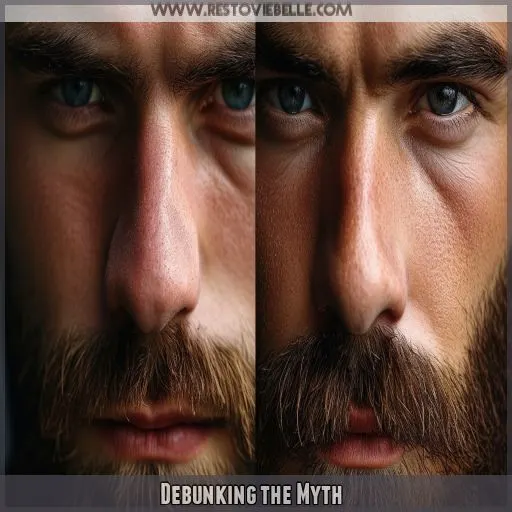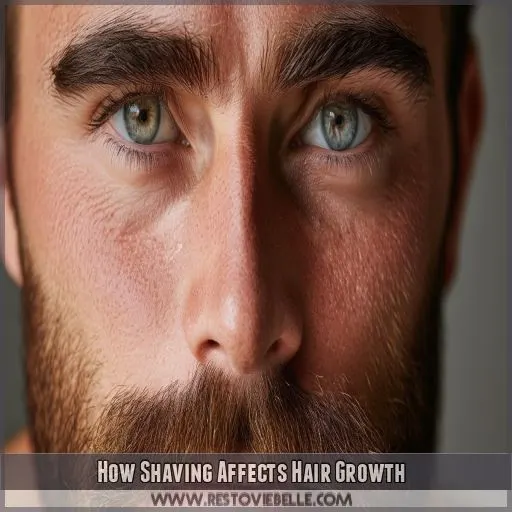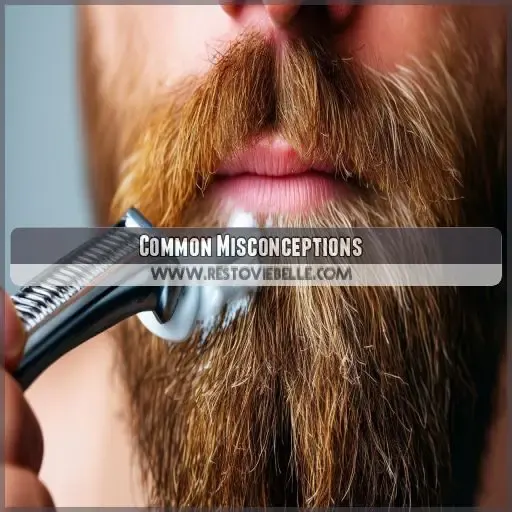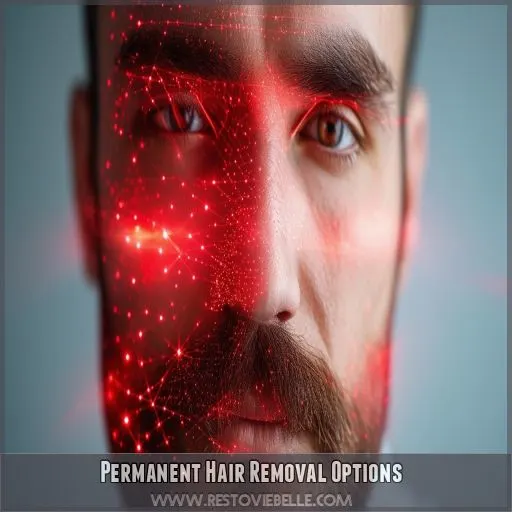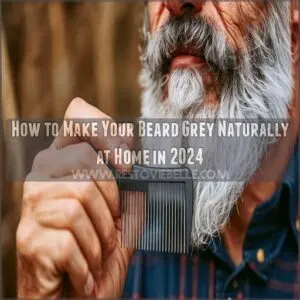This site is supported by our readers. We may earn a commission, at no cost to you, if you purchase through links.
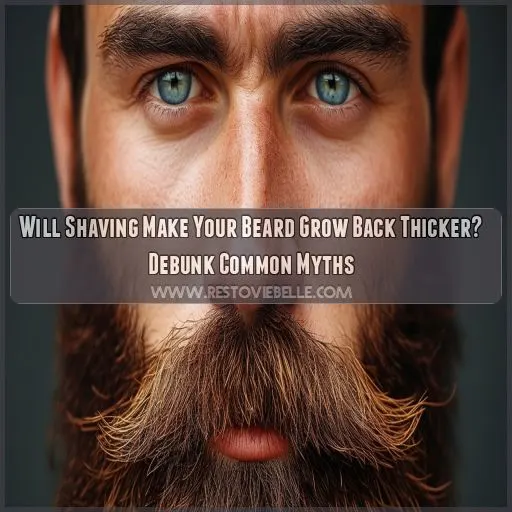 No, shaving won’t make your beard grow back thicker. It’s a common myth, but there’s no scientific evidence to back it up. Hair thickness and growth rate are controlled by your genetics and hormones, not by how often you shave.
No, shaving won’t make your beard grow back thicker. It’s a common myth, but there’s no scientific evidence to back it up. Hair thickness and growth rate are controlled by your genetics and hormones, not by how often you shave.
When you shave, you cut hair at the surface, giving it a blunt tip that can feel coarser as it grows out. This doesn’t mean it’s growing back thicker.
For smoother skin, exfoliate before shaving, shave in the direction of hair growth, and use shaving cream.
Curious about how shaving really affects your hair growth? You’re about to find out.
Table Of Contents
- Key Takeaways
- Debunking the Myth
- How Shaving Affects Hair Growth
- Shaving Techniques for Smoother Skin
- Hair Growth Stages
- Common Misconceptions
- Permanent Hair Removal Options
- Frequently Asked Questions (FAQs)
- Will my beard grow thicker if I shave it?
- Is shaving good for beard growth?
- Does letting your beard grow make it thicker?
- Will shaving help a patchy beard?
- Does shaving make your beard grow bigger?
- Does shaving make hair grow back thicker?
- Should you shave your beard more often?
- Why does my beard look thicker when it grows again?
- Why is my beard thicker after I Shave?
- Does shaving change your beard follicles?
- How often should facial razors be replaced?
- Are electric razors better than manual ones?
- What are alternatives to shaving creams?
- Can certain foods promote beard growth?
- How can I prevent shaving-related acne?
- Conclusion
Key Takeaways
- Shaving your beard won’t make it grow back thicker. It’s like chasing a rainbow; you’ll never reach it!
- Don’t fall for the old wives’ tale that shaving makes hair grow back coarser. It’s just an illusion created by the blunt tips of shaved hair.
- If you want a thicker beard, focus on good grooming habits, a healthy diet, and reducing stress. You can’t control genetics, but you can give your beard the best chance to flourish.
- If you’re tired of shaving, consider laser hair removal. It’s like a magic wand for unwanted hair, but be prepared for multiple sessions and some potential side effects.
Debunking the Myth
You might think shaving your beard makes it grow back thicker, but clinical studies have found no evidence to support this myth. Research shows that hair regrowth remains consistent regardless of shaving frequency.
No Evidence of Thicker Hair
You may have heard the myth that shaving causes your hair to grow back thicker, but the truth is there’s no evidence to support this claim. Your hair’s thickness and growth rate are determined by your genetics and hormones, not by how you remove it. So don’t worry – shaving won’t make your beard sprout back like a forest.
Clinical Studies
Clinical studies further debunk the myth that shaving causes thicker hair regrowth. Key findings include:
- Shaving Frequency: Studies show no effect on hair thickness or growth rate.
- Razor Quality: High-quality razors prevent irritation but don’t affect hair follicles.
- Skin Sensitivity: Proper shaving techniques reduce irritation, not growth rate.
- Hair Growth Stages: Hair grows in cycles; shaving only removes dead cells at the skin’s surface.
How Shaving Affects Hair Growth
Shaving doesn’t change the rate of your hair’s regrowth or its texture. It may seem that way because the cut hair has a blunt tip, making it feel coarser as it grows out.
Hair Regrowth Rate
When you shave, you’re only cutting the hair at the surface, not affecting the follicles. Your hair regrowth rate stays the same because it’s governed by the hair growth cycle, hormonal influences, and genetics, not by shaving frequency.
While shaving, using a good razor is important to avoid skin sensitivity or razor burns.
Importantly, shaving doesn’t cause hair thickening, hair loss, or change in natural hair color.
Hair Texture
Shaving changes how your hair feels, not how it grows. By cutting hair at the shaft, it creates blunt, uneven edges that feel thicker. This new stubble can also be more noticeable, especially darker hair. To improve texture:
- Exfoliate before shaving
- Use quality shaving cream
- Shave in the hair growth direction
- Moisturize post-shave
- Prevent ingrown hairs and razor burn by using fresh razors
Shaving Techniques for Smoother Skin
To achieve smoother skin while shaving, always exfoliate beforehand to remove dead skin cells and shave in the direction of hair growth to minimize irritation. These techniques help reduce the risk of razor burn and ingrown hairs.
Exfoliating
Exfoliating before shaving removes dead skin cells, paving the way for a smoother shave and reducing cuts, itchy skin, and ingrown hairs. Use exfoliation tools like scrubs, brushes, or chemical exfoliants. For sensitive skin, choose gentle exfoliation methods to avoid irritation. Exfoliate 2-3 times a week to keep pores clear, ensuring hair pollutants and stress have minimal impact on your skin.
| Exfoliation Tools | Benefits | Frequency |
|---|---|---|
| Scrubs | Removes dead skin cells | 2-3 times a week |
| Brushes | Clears pores | 2-3 times a week |
| Chemical Exfoliants | Gentle on sensitive skin | 1-2 times a week |
| Gloves | Easy to use | 2-3 times a week |
Shaving Direction
Exfoliating is just the first step. Next, focus on shaving direction to avoid irritation and achieve smoother skin.
- Shave with the hair growth direction to minimize bumps and cuts.
- Use a sharp blade for an even cut.
- Apply shaving gel or lotion to reduce friction.
- Be mindful of shaving frequency to prevent shaving sensitivity or contact dermatitis.
Master these techniques for the best results.
Hair Growth Stages
As your hair grows, it forms within follicles and is lubricated by sebum. Understanding the stages of hair growth can help you better manage your beard and achieve the look you desire.
Hair Formation
Hair forms in hair follicles deep in your skin. The process begins with proteins and blood, which create the hair shaft. As it grows, the hair exits the follicle, emerging through your skin’s surface. By then, those cells are dead. Here’s a quick breakdown:
| Phase | Duration | Characteristics | Hair Texture | Hair Shaft |
|---|---|---|---|---|
| Anagen | 2-7 years | Active growth | Fine | Long |
| Catagen | 2-3 weeks | Intermediate | Thinning | Shortening |
| Telogen | 3 months | Resting | Stagnant | Shedding |
| Exogen | Varies | Shedding phase | Falling | Disconnect |
| Return | Cycle | Begins again | New growth | Fresh |
Sebum Lubrication
Sebum production is essential for maintaining hair follicle health. This natural oil lubricates hair as it grows, preventing skin dryness and irritation.
When you shave, sebum continues to protect new hair, ensuring smooth regrowth. Proper shaving techniques, like using moisturizing products, can enhance skin comfort.
Whether you’re shaving your armpits, arms, or legs, keeping sebum in mind helps maintain healthy hair and skin.
Common Misconceptions
Many people believe that shaving makes your hair grow back thicker and darker, but this is a common misconception. Scientific studies have proven that neither the color nor the thickness of your regrown hair is affected by shaving.
Hair Color
One common myth about shaving is about hair color. When you shave, your regrown hair may look darker. This is because newly exposed hair hasn’t been lightened by sun exposure or chemical exposure from products like hair dyes.
Your natural hair color can seem darker at the base, making stubble more noticeable. However, shaving doesn’t actually change your hair color. It’s just the way the hair regrowth appears.
Hair Thickness
Let’s clear up misconceptions about hair thickness. Shaving doesn’t make your beard grow back thicker.
The perceived change in texture is due to the blunt ends left after shaving, making hair feel coarser. Hair’s darker appearance post-shaving is because of the contrast with your skin.
Permanent Hair Removal Options
If you’re looking for a long-term solution, laser hair removal might be a good option. It often requires 5-8 treatments with periodic maintenance to effectively reduce hair growth.
Laser Hair Removal
Laser hair removal can be a game-changer if you’re tired of shaving. This method uses concentrated light to target hair follicles, reducing or eliminating regrowth.
It’s effective and long-lasting but be prepared for multiple sessions. Costs can be significant, but many find the investment worth it due to the convenience and smooth results.
Just confirm your skin type and hair color are suitable for the best outcome.
Maintenance Treatments
Maintenance treatments for laser hair removal are essential. You’ll need 5-8 sessions, with regular touch-ups, to achieve lasting results.
While it’s effective, the cost can accumulate. Additionally, suitability varies; certain skin types and hair colors respond better. Beyond that, factors like genetics and hormones greatly impact outcomes.
Consistent maintenance ensures your skin remains smooth, keeping unwanted hair at bay. Effort and investment pay off in the long run.
Frequently Asked Questions (FAQs)
Will my beard grow thicker if I shave it?
It might seem like a coincidence, but shaving doesn’t make your beard grow back thicker. Despite popular belief, clinical studies show that shaving only cuts hair at the surface, without impacting growth rate or thickness.
Is shaving good for beard growth?
Shaving doesn’t make your beard grow thicker. It simply cuts the hair at the skin’s surface, giving an impression of thickness. For healthy beard growth, focus on proper skincare, nutrition, and reducing stress.
Does letting your beard grow make it thicker?
Letting your beard grow won’t make it thicker. Genetics and hormones determine beard thickness. Shaving doesn’t alter hair structure. Proper care, like moisturizing and managing stress, can help maintain healthier, fuller-looking facial hair.
Will shaving help a patchy beard?
Trying to make your patchy beard thicker by shaving won’t work; it’s just a wild goose chase. Be patient and consider other methods like proper grooming, a balanced diet, and perhaps specialized beard products.
Does shaving make your beard grow bigger?
No, shaving won’t make your beard grow thicker. Hair grows from follicles beneath your skin, not affected by shaving. It may seem thicker due to the blunt tips, but regrowth remains consistent in texture and thickness.
Does shaving make hair grow back thicker?
Old wives’ tales die hard, but shaving doesn’t make hair grow back thicker. Medical studies show that hair regrowth isn’t affected by shaving; it just looks coarser because of its blunt tip and lack of sun exposure.
Should you shave your beard more often?
Shaving your beard more often won’t make it grow back thicker or faster. Instead, focus on proper shaving techniques and aftercare to maintain healthy skin and a well-groomed appearance.
Why does my beard look thicker when it grows again?
Your beard looks thicker after regrowth because shaving cuts hair at the coarser base, and the lack of sun and chemicals can make it appear darker. In reality, shaving doesn’t change your hair’s thickness or growth rate.
Why is my beard thicker after I Shave?
Ironically, shaving makes your beard seem thicker because cutting hair at the base creates a blunt edge, which feels coarser. Additionally, the regrowth may appear darker due to the lack of sun exposure.
Does shaving change your beard follicles?
Shaving doesn’t change your beard follicles. The process only cuts hair at the skin’s surface. Regrowth may appear thicker or darker due to the blunt tip, but the follicle structure remains unchanged.
How often should facial razors be replaced?
Replacing your facial razor is paramount—like changing a tire on a Formula 1 car. Exchange it every five to seven shaves to sustain a smooth experience, prevent irritation, and guarantee exceptional razor performance.
Are electric razors better than manual ones?
Electric razors offer convenience and speed, reducing cuts and irritation. They’re great for quick shaves and sensitive skin, but manual razors can provide a closer, smoother shave. Choose based on your skin type and shaving preferences.
What are alternatives to shaving creams?
Using aloe vera gel as an alternative to shaving cream is like substituting a chef’s knife for a paring knife—both get the job done, but with different results. Other options include coconut oil, conditioner, or baby oil.
Can certain foods promote beard growth?
Certain foods, like eggs, nuts, and leafy greens, can help promote beard growth. They’re rich in protein, biotin, vitamins, and minerals that nourish hair follicles, potentially enhancing your beard’s thickness and growth rate.
How can I prevent shaving-related acne?
Think of acne prevention like steering a ship smoothly. Exfoliate to remove dead skin, use a fresh razor, shave with the grain, and apply non-comedogenic moisturizer post-shave. This helps keep your skin clear and calm.
Conclusion
Shaving won’t magically transform your beard into a dense forest. The idea that shaving will make your beard grow back thicker is just a myth.
While shaving can give hair a blunt tip, making it feel rougher, it doesn’t affect the thickness or rate of hair growth.
For smoother skin, don’t forget to exfoliate, shave in the direction of growth, and use shaving cream.
Consider professional hair removal options if you’re seeking permanent results.

